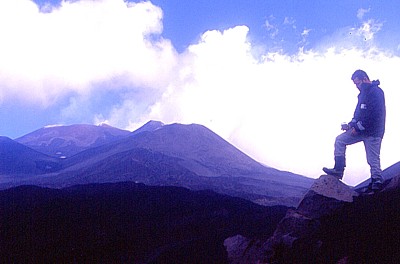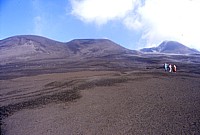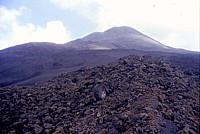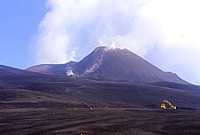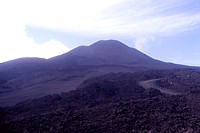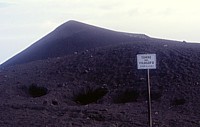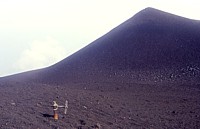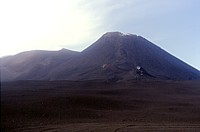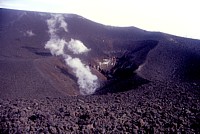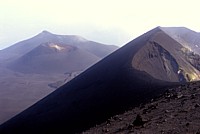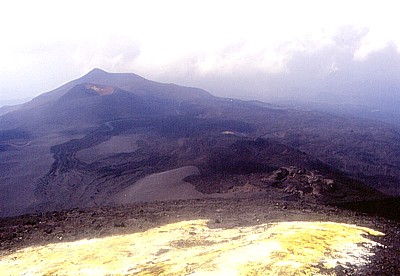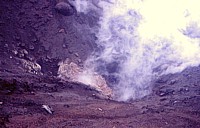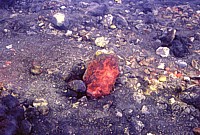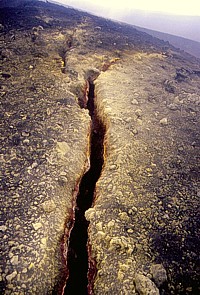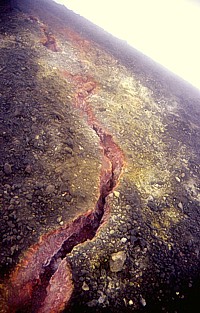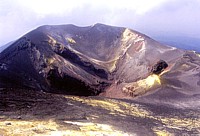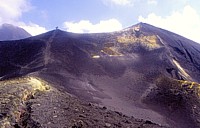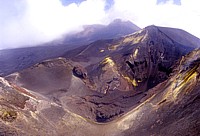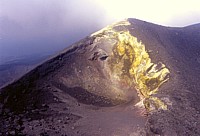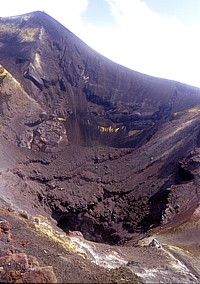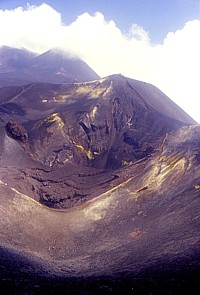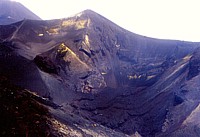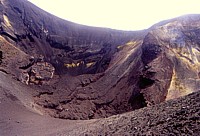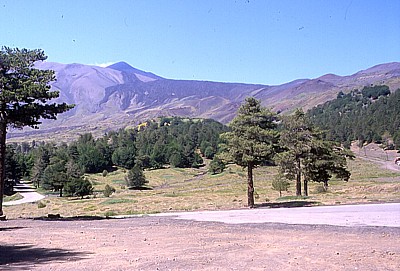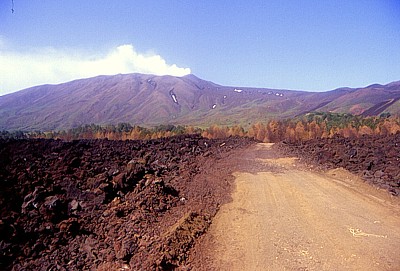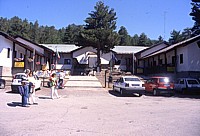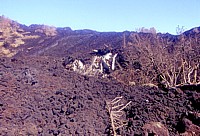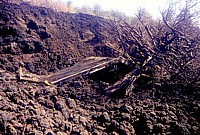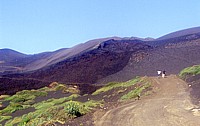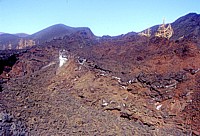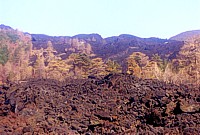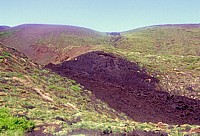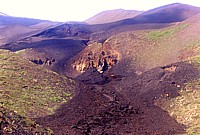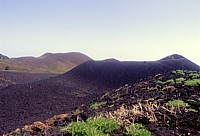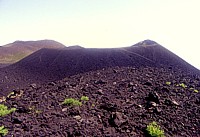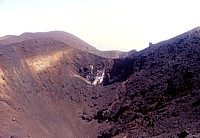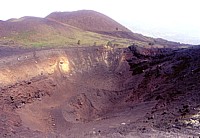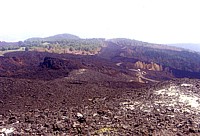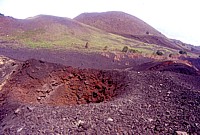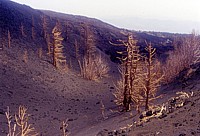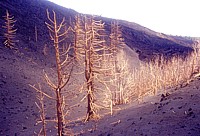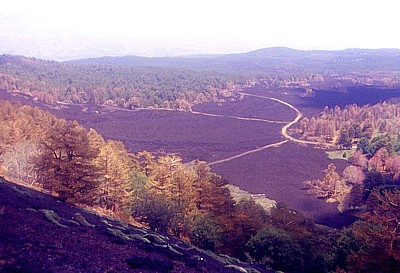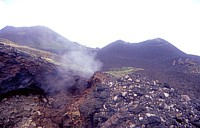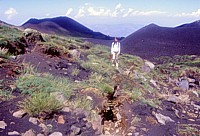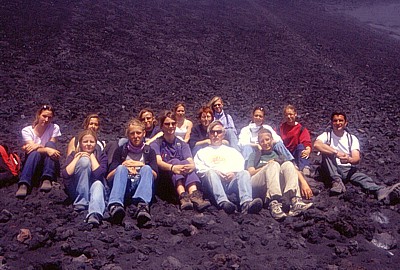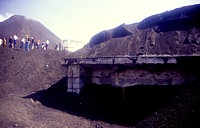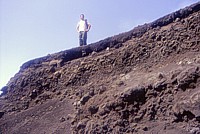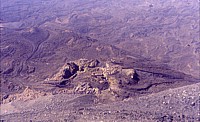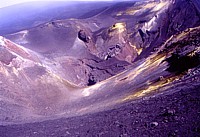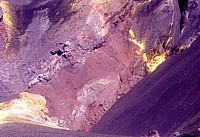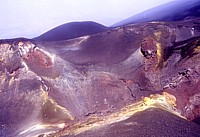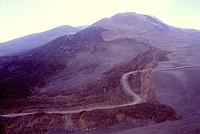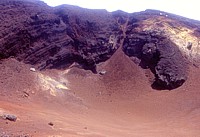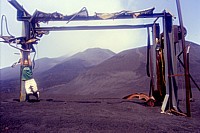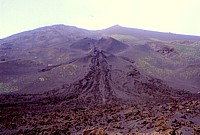| Etna
index |
||
| Geology | Geological history | Cones and craters |
| Eruptive characteristics | Eruptions before 1971 | Eruptions since 1971 |
| Etna and Man | References | Web sites |
| Weather forecasts | FAQ | Latest news |
Etna
photo gallery: 2003
Return to Etna
![]()
After the enormous stress caused by the 2002-2003 eruption, I felt much detached from Etna in early 2003, a feeling that was amplified by a series of events of more or less private nature that continued through April 2003. Starting in June 2003, a vigorous re-discovery started with numerous excursions to the sites of the latest eruption, and the volcano appeared strongly altered, and more fascinating than ever before. Places I had known well before had changed beyond recognition, other places that I had not visited since long time were still the same but startingly beautiful. The photo series below give an impression of the "new" Etna and its rapidly changing landscapes.
Part 1: June 2003 (see bottom of page for more recent photos)
On 2 June 2003, I returned to the site of the 2002-2003 eruption on the southern flank for the first time after the end of the eruption. Dramatic changes had taken place, the most impressive being the presence of two enormous pyroclastic cones where before the eruption there had been a smooth slope leading up to the Torre del Filosofo mountain hut. The area to the east and southeast of these cones is a desert of ash and scoriae, very easy to walk on. Until October 2002, this area had been a chaos of lava flows erupted during the 2001 eruption. A wooden hut erected by the Etna mountain guides in the summer of 2002, which served as a bar and souvenir shop for tourists, had vanished below up to 60 m of new pyroclastics, along with a cluster of smaller cones formed during the 2001 eruption.
Etna, upper southern flank, 9 June 2003
The visit was made during the late afternoon, with some weather clouds casting shadows on the terrain, which explains why some of the photographs are rather dark and low in contrast. It was possible to stay only briefly on the rim of the lower of the two newly formed (2002-2003) craters; a tour around this crater was made four days later (see next series).
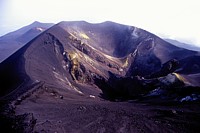 |
Two views of the crater of the lower new cone from slightly different angles. This crater contains at least six irregularly spaced vents and displays spectacularly colorful sulfur deposits |
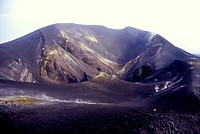 |
Etna, upper southern flank, 13 June 2003
Lighting conditions are quite different compared to the previous (9 June) series as the visit was made during the early morning, but clouds often covered part of the scene. This time it was possible to do a near complete round trip around the lower of the two newly formed (2002-2003) craters, allowing to portray it from different viewing angles.
The
place seen here is what on maps is called "Piano del Lago",
which means "Plain of the Lake". It was a gently sloping,
flat area extending from the Montagnola (the sharp peak seen in
the distance) at about 2600 m elevation to the base of the summit
crater complex. Only one prehistoric cone, Monte Frumento Supino
(which is out of the picture to the right) lay in this area until
2001. During the eruption of July-August 2001, a large new cone
formed just to the north of the Montagnola (the gaping crater seen
in the distance in front of the Montagnola). The eruption of October
2002-January 2003 led to the growth of two much larger cones, and
all lavas seen in the middle ground were erupted from several vents
at the base of the more southerly of these cones. The photograph
was taken from the southern side of the same cone, looking south |
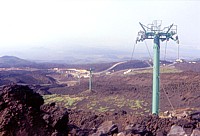 |
Left:
some of the poles of the cable-car survived both the 2001 and 2002-2003
eruptions |
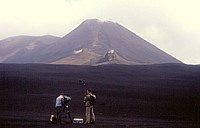 |
Etna, Piano Provenzana and Northeast Rift, 18 June 2003
Piano Provenzana and the eruptive vents that brought so much destruction during the first days of the 2002-2003 eruption were visited during the early morning of 18 June 2003, with the sun standing still low, which resulted in the strong reddish hue visible in may of these photographs.
Piano
Provenzana, located on the north-northeastern flank of Etna at about
1850 m elevation, appeared to be the most peaceful spot on the volcano
until that fateful morning of 27 October 2002. Within twenty-four
hours the once verdant plain (photo above, taken in July 1999),
the entire tourist complex it hosted, and large sections of the
single access road were transformed into a desert of blocky lava.
A new dirt road leading to the devastated place was constructed
in March-April 2003 (photo below), but yet needs to be paved. |
Etna, Piano Provenzana and Northeast Rift, 22 June 2003
A second visit to Piano Provenzana and the nearby eruptive vents of the early phase of the 2002-2003 eruption (October-November 2002) was made on 22 June 2003, and some of the eruptive vents were studied in more detail. Differently to the visit four days earlier, there was stronger fumarolic activity in some sites. Furthermore it was possible to visit the main vent of the eruption, from which much of the lava which devastated Piano Provenzana was erupted. The lava flowed through a deep channel, resembling the "barrel of a gun" from which the lethal shot onto the tourist complex was fired.
Looking
down at the site which once hosted the tourist facilities of Piano
Provenzana, 22 June 2003. The view is from the ridge above the plain,
which actually is the crest of a normal fault on the eastern margin
of the Northeast Rift. Much of the plain is covered with lava from
the first phase of the latest eruption, October-November 2002. New
dirt roads have been laid across the lava field and are planned
to represent the backbones of a new tourist complex, yet to be built |
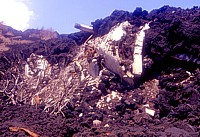 |
Left:
a closer look at the remains of the hotel "Le Betulle" |
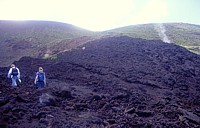 |
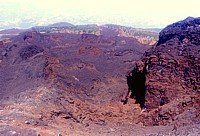 |
"The barrel of a gun": this tremendous chasm was the vent which fed the main lava flow that destroyed Piano Provenzana, which issued through a deep lava flow channel |
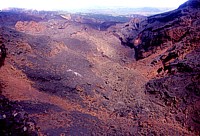 |
Etna, southern flank, 26 June 2003
Like the 22 June visit to the Piano Provenzana area, the 26 June 2003 excursion to the craters of the 2001 and 2002-2003 eruptions on the southern flank was made together with a group of students from the Gymnasium Heidberg, near Hamburg, Germany. This was organized by Geology teacher Wolfgang Fraedrich, who had made similar excursions in the past five years, which I had the pleasure to accompany and support logistically as well. During the week between 22 and 28 June, we visited many areas on and around Etna, including the two major hikes at Piano Provenzana and on the southern flank. The group was highly motivated and enthusiastic, and remarkably apt to moving around in the often hostile terrains on the volcano. The 26 June excursion started at the huge craters formed during the 2002-2003 eruption and led to the "Belvedere" lookout, the large cone formed during the 2001 eruption (Monte Josémaria Escrivà), the Montagnola, and the 2001 vents at 2100 m elevation.
Excursion
group from the Gymnasium Heidberg, Hamburg, Germany, at the eastern
base of the huge pyroclastic cones formed during the 2002-2003 eruption.
Mountain guide Andrea Mazzaglia is at right, Geology teacher Wolfgang
Fraedrich in the center. Thanks to all of you for making this a
truly memorable hike! |
Part 3: The 1614-1624 lava field, 24 July 2003
Copyright © Boris Behncke, "Italy's Volcanoes: The Cradle of Volcanology"
Page set up on 11 June 2003, last modified on 18 October 2003

